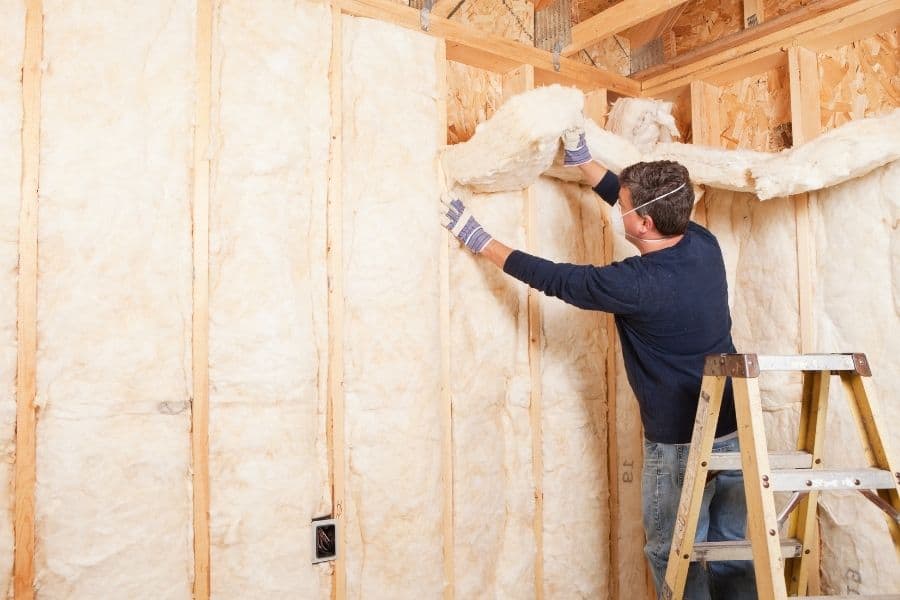If you live in an apartment building or condo, chances are you’ve heard some pretty loud neighbors. If you’re lucky enough to have a room facing the street, you might even be able to hear the music blasting out of their windows.
But if you want to keep your peace and quiet, there’s a way to block out the noise without having to move into a new place.
Let’s find out how to dampen bass coming through a wall below.

This page contains affiliate links, and as an Amazon Associate we earn from qualifying purchases which means we receive a small commission when you make a purchase, at zero cost to you.
Why Does Bass Go Through Walls?
Bass is easy to deal with if you know how to do it. Before we look at ways to block bass, we should examine what bass is and why is it the most difficult sound to control.
Bass is low frequency and can move through solid surfaces such as brick and concrete. When this happens, you may feel the sensation of structural noise, which is caused by vibrations transmitted through your walls, ceilings and floors, rather than through air.
In other words, the bass can often be felt in the form of vibrations on walls and floors.
There is a full impact to the sound of bass. The bass sound can be played at a low volume, yet the effect can still be felt, similar to how people who are hard of hearing experience the sensation of vibration when they hear music. This is because bass causes vibrations that move through solid structures.
Therefore, reducing bass noise is really a challenge. You can’t simply soundproof it like any other noise. Soundproofing materials must be strong enough to reduce bass noise.
But wait! There is still a way to reduce the level of bass noise in your house. Fortunately, I have compiled a list of ways to deal with it.
How to Dampen Bass Coming Through a Wall
1. Install Bass Traps on the Wall
Installing bass traps on the walls of the house will help. Bass traps are acoustic foams that fit into the corner of the wall, come out approximately six inches on either side and have ripples.
Bass traps are specifically designed for use in music rooms to absorb low-frequency sound waves. These traps will take the kinetic energy of the bass vibrations and convert them into heat energy. When the bass vibrations come into direct contact with the bass trap, they lose their amplitude.

However, it’s important to note that bass traps are designed to prevent bass from escaping a room, not entering it, so they may not be the solution you want.
Instead, they may be useful if, for instance, someone in your home listens to loud music (or watches TV) and you want an effective way to block the bass coming from an adjacent room. Buy a pack of four and stick them up in the corners of the room. Combine this with other soundproofing techniques below and you should end up with an effective solution that blocks the bass coming from a neighboring room.
2. Create a Separate Wall
This is not a joke. If you create a separate wall that doesn’t touch the existing room structure, you can make it soundproof. It’s basically creating a room inside a room.
That way, the low-frequency sounds passing through the building won’t be able to vibrate the inner walls. So they’ll just disperse in the small space between two walls.
This technique works because bass sounds can travel through brick and concrete walls easily. By building a second wall that is separate from an existing wall, you remove the space the bass energy needs to travel and give it somewhere else to go.
Creating a room inside another room is going to cost quite a bit of money. You will need to spend money on buying the materials and time to do the work. But, even if you decide to hire a professional team, you should still consider investing some money into the project. Also, for optimal coverage, it might be worth floating the floor and dropping the ceiling as well.
3. Install Resilient Channels
If you find creating a room inside a room is too extreme, an alternative is to install flexible strips of metal called “resilient channels”. The resilient channels are designed to reduce sound travel by improving the sound insulation of walls and ceilings.
To make decoupling more efficient, they can be installed in between stud-work and drywall. Resilient channels work as shock absorbers but require correct installation to be effective.
4. Block the Wall With Furniture
Another low-cost option is to use the furniture you already have at home to block off the dividing wall between you and your neighbor or the room next door. Furniture such as bookcases and wardrobes can be placed against the wall to dampen the bass sound and you could also place a blanket over the furniture to add another layer of absorption.

This is a simple method to reduce the bass noise that you experience without breaking the bank as you’re using the items you already have at home.
5. Insulate Cavities in the Wall
Wall cavities are the enemy of sound-proofers. They allow sound waves to bounce around inside the empty space, amplifying them. This is why bass sounds from the sound system next door can be louder than they actually are.
A great way to solve this problem is to fill the wall with dense fiberglass insulation. The fibers fill the empty space, which reduces the amount of echo and reverberation. The material is dense enough to prevent sound waves from passing through the wall, which effectively damps out the bass sounds.

While this option alone may not be sufficient to completely block bass frequencies (or any other frequency), it can be combined with other methods (like resilient channels or decoupling) to provide a fairly effective solution.
6. Soundproof the Door Spaces
If you have soundproofed your walls but the problem still persists, the bass sounds may be coming through your doors and windows.
You can soundproof your doors using dampening door seals, which are strips that you put over the gaps between the door and frame to reduce the amount of bass noise coming into your home. They are not the prettiest solution, but they are inexpensive and effective.
This method is the cheapest but still among the most effective for dampening bass noise from outside. To install this seal, you can purchase it on Amazon and fix it yourself. Simply cut the rubber weatherstripping to fit the size of the door. Place the cut strips around the door to seal it. Seal the gaps from inside. Sealing from outside will make your doors look ugly.
This technique will help to reduce the noise from outside but if you don’t like this, keep reading to discover other techniques to dampen the sound.
7. Install Draft Stopper Under the Door
There must be a gap between the floor of your room and the door so that the door can close and open smoothly. But this gap also lets the bass sound through the door. The bigger the gap, the more sound it lets through the door.
To solve this problem, buy a draft stopper and install it under your door. These stoppers are also called “door sweeps.” When installed under the door, they slide smoothly over carpets, wood, and laminate floors without leaving any marks or scratches on the floors.
8. Use Soundproofing Curtains or Blankets
Soundproof curtains should not be your primary choice for blocking bass sounds, but you can use them to block some of them. They will help, but you should focus primarily on weak areas, such as doors and windows. You can also hang them in front of walls if you want to. Hang them like you would hang regular curtains. They’re a cost-effective solution that isn’t overly intrusive.
Soundproof curtains are different from regular curtains because they have an additional layer of sound dampening fabric inside them. They are thicker, so they will block both high and low frequencies equally well. However, they will be better at blocking higher frequencies, but they will make some difference to bass too. As such, you should go as thick as you can afford, but don’t expect miracle results.
9. Your Floor Needs Soundproofing Too
A very strong bass can vibrate throughout your house if not dampened. To protect against such vibrations, you must install soundproofing materials on the floor. You can do this by applying the following techniques.
Lay down heavy rugs or carpets on the floor. Heavy rugs will absorb the bass vibration that would otherwise be transmitted through the floor and cause disturbance in the room. Use thick and heavy carpets, they are more efficient than light ones. The results are better when the carpet is heavier. But there are other ways to do this also. You can place rubber floor mats and MLVs under the carpeting as well.
10. Soundproof Your Ceilings
If you have a home office or are planning one, soundproofing the ceiling can be an essential step. The best way to do this is by installing acoustic panels on the ceiling. These panels absorb sound waves especially bass frequencies and prevent them from reaching the room below. They also help reduce noise pollution in the area around your room.
Alternatively, if the bass noise is low to moderate, a soundproofing blanket will do a good job of soundproofing your ceiling. It helps to reduce the vibrations and dampen bass noises from the room above you.
11. Use White Noise to Dampen the Bass
White noise is a good tool for blocking out all audible frequencies, including low frequencies. It is an amalgamation of all audible frequencies. Even though bass noise is felt more in its vibration than it is in its sound, bass sounds are still just a sound frequency, like any other.
Therefore, white noise machines can be very effective at reducing the effects of bass noise. They are inexpensive devices that do not require drilling into walls or taking apart walls.
Some white noise machines make a humming sound, while others can play different sounds such as ambient sounds and nature. These devices help reduce bass noise disturbances and even improve your quality of sleep, but they do not provide complete silence.
12. Wear Noise-canceling Headphones
Some of the tips above may be more work than you thought they would be.
In that case, consider using noise-canceling headphones. They can be a simple way of blocking out bass sounds from next door without having to get the toolkit.
Noise-canceling headphones allow you to listen to whatever you want without having to compete with the other sounds around you. They also allow you to listen to your favorite media at a lower volume level as you don’t need to crank it up to hear it.
13. Talk to Your Neighbors
This is probably not the answer that you want to hear but speaking to your neighbors can be the cheapest and fastest solution. Talking to your neighbors is not always easy but if the bass noise is truly unbearable then this could be the only option. Of course, they might not be receptive, but if they are and cut down the bass noise without any hassle then the problem is solved!
Politely discuss the issue with your neighbors face to face. You may be surprised at how willing they are to listen to you and how many options there are to solve the problem.

If you want to talk to your neighbors, whether it’s in-person or over the phone, remember to be polite and friendly. Try to casually introduce yourself and ask them to kindly keep it down if they are making too much noise. You could even ask them to agree to silent periods during the day.
Despite your best efforts, some folks might not be receptive to such suggestions. If that’s true, or if you simply do not want to engage with your neighbor in the first place, then talk to the landlord or management company. In rare cases, it may even be necessary to call the police. But, it’s always best not to approach these things with anger or confrontation.







